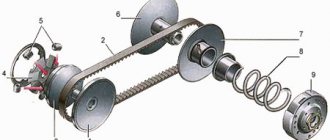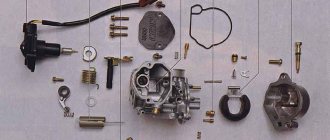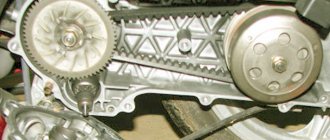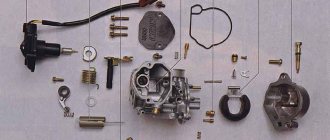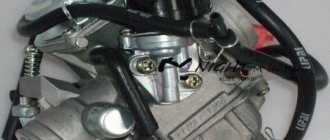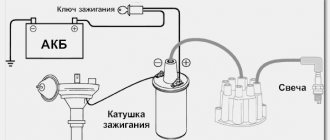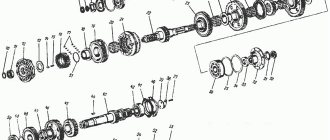A motorcycle clutch is a serious unit that transmits torque from the engine to the rear wheel drive (gearbox). In part, it is classified as consumables, since it needs to be changed regularly. On the other hand, this mechanism requires precise tuning and the ability to control the bike, which can significantly extend its service life.
Motorcycle clutch device
Modern motorcycles are manufactured mainly with complex multi-plate clutches. The clutch allows you to disconnect and smoothly connect the engine to the gearbox, which is necessary for starting, changing gears, etc. In addition, by slipping under dynamic (shock) loads, the clutch protects engine and transmission parts from overloads and damage. Inside the clutch basket there is a drum, discs arranged in turn, friction and metal, springs or a diaphragm and a pressure plate (also called a release plate). The number of discs and springs depends on the motorcycle model. When the clutch is depressed, the steel discs slide between the friction discs, but if the discs are compressed, the basket and drum rotate together.
"Dry" and "wet" clutch
Most manufacturers use an oil bath clutch (called “wet”). For city motorcycles, it has certain advantages: the oil helps the discs not to overheat and protects them from combustion. The discs themselves rotate in the “bath” much smoother, which increases the service life of the clutch, and its operation is generally more comfortable for most drivers. But there are also disadvantages: microparticles from worn discs enter the oil and can clog the oil filter, as well as leave deposits on the crankcase. The performance of the clutch is highly dependent on the quality of the filled oil. Racing teams use dry clutch motorcycles because speed and shifting precision are more important than durability in competition. The same system is installed on some standard motorcycles, for example, Ducati motorcycles. The dry clutch gives these motorcycles a specific sound that makes them easy to recognize. According to the principle of operation, a dry clutch does not differ from a wet one, however, it overheats faster, is susceptible to external influences (moisture and dirt have a particularly negative effect), has a shorter service life and, in general, can be harsh for the average driver.
Why does the clutch slip?
Clutch wear can be indicated by noise in the crankcase, vibrations and tight squeezing of the lever. However, these factors may not indicate a breakdown or may be a feature of a particular motorcycle model. But slipping when switching is a more serious symptom. If you notice that shifting has become too difficult, it is difficult to catch neutral gear, the speed rises when you press the gas, but the motorcycle does not move - this is a sign of problems with the clutch. The most common causes of a slipping clutch can be:
- The motorcycle spent a long time in the cold, which is why the oil lost its properties, and the discs “stuck” to each other and do not move. Treatment requires thorough heating of the oil and repeated squeezing and releasing of the clutch. The use of high-viscosity oil at low temperatures can lead to incomplete disengagement of the clutch. If the problem occurs constantly, you should change the oil to a less viscous one (for example, replace 15W-50 with 10W-40);
- Low-quality engine oil was filled in: perhaps they saved money on maintenance or filled in a fake, in any case, the oil needs to be changed urgently to save the disks (please buy fresh oil from official distributors!);
- Try adjusting the clutch, maybe the cable is too tight or too loose;
- If you are sure that the problem is not in the oil, and adjustment does not help, you will have to disassemble the clutch basket: in most cases, the reason will be the development of ferodo coating on the friction discs - they must be replaced. You can find the standard thickness of clutch discs (both friction and steel) in the service manual for your motorcycle;
- The clutch may slip if there is insufficient spring pressure. Even steel springs lose their properties over time and require replacement;
- In rare cases (usually with serious mechanical impact or gross violations of operating conditions), replacement of metal discs or even complete replacement of the clutch basket is required.
106_moto_0511_076
...and disengage the cable itself.
Sometimes it is convenient to press the lever on the steering wheel and place some kind of stop under the shutdown lever. It will allow you to remove the end of the sheath from the recess, and then easily remove the cable itself. ...and disengage the cable itself. Sometimes it is convenient to press the lever on the steering wheel and place some kind of stop under the shutdown lever. It will allow you to remove the end of the sheath from the recess, and then easily remove the cable itself.
Replacing a clutch on a motorcycle
We recommend that you trust clutch replacement to professionals in a specialized service.
But, if you want to save money, you can change the clutch discs and springs yourself. Be prepared for the fact that this will require a lot of time and effort, and you will need special tools to disassemble the box. Also, arm yourself with a service manual; you will need it to check the standards for the production of clutch elements.
First, remove the plastic, then the clutch cover itself; depending on the model, it can be located either on the right or on the left side. Next, you need to disconnect the clutch cable if it is on the same side of the cover. Under the cover you will see the entire clutch mechanism. Next you need to remove the bolts with the pressure springs (if they are stretched, they need to be replaced), and after them you need to remove the pressure plate. Behind it you will see all the other disks.
Remember, or better yet, write down the sequence of installation of the clutch discs; the basket may contain discs of different types and sizes. Behind the first friction disc you can notice two or three small rings - these are a washer and a diaphragm spring, they are needed for the clutch to engage smoothly. Without them, the clutch will engage with a strong jerk, so do not lose them and put them in place in the correct position. Look at which discs are worn out and require replacement (usually friction discs). They are convenient to purchase and replace as a set. Steel wheels may have a coating that can be cleaned. They require replacement when they become thin and show signs of wear.
You may need a special tool to remove the drum. Check the basket and drum for signs of wear. Please note that with long-term use, along with the clutch, the basket also wears out, and wear appears on its slots. The damaged basket, unfortunately, also requires replacement. After checking, the drum and basket can be put back together.
Before assembling the entire mechanism, new discs must be soaked in the engine oil that will be filled. After this, you need to assemble the disks in the correct order, then insert the pressure disk and screw it with bolts. The first and last discs have special gaskets, do not forget to change them. It is impossible to assemble the clutch without gaskets, as they protect the discs from the strong pressure of the box. Pay special attention to the diameter and length of the springs, as well as their tightening torque when installing the clutch. To do this, use a torque wrench.
Then close the box with a lid, attach the cable and adjust its tension, leaving 10-15mm
. freewheel. If the free play is too large, the clutch will “drive”, that is, the motorcycle will move even with the clutch depressed. If there is no free play at all, when the lever is released, the clutch may remain pressed and the motorcycle will begin to slip.
001_moto_0511_076
Proper cable adjustment is the key to long clutch life.
It takes seconds, no tool is needed, but it lasts a long time. Proper cable adjustment is the key to long clutch life. It takes seconds, no tool is needed, but it lasts a long time.
If after adjustment the signs of slipping disappear, consider yourself lucky: the motorcycle can be ridden. But this rarely happens. If the clutch slips even when the cable is adjusted correctly, then it’s time to change it. Slowly, preferably in low gears, head to the repair site, trying to keep slipping to a minimum. Many modern bikes use a hydraulic clutch drive. It does not involve any adjustments and, in principle, cannot cause the clutch to slip. Therefore, slipping on such motorcycles is almost always a sign of serious wear on the unit.
There is another picture - the clutch “leads”: the lever is squeezed all the way, and the motorcycle tries to move forward. Gears are difficult to shift, and neutral is almost impossible to catch. In cold weather this is normal; When the frozen oil warms up, everything will return to normal. But if the motorcycle has spent the winter in “hibernation”, the discs can “stick” tightly to each other. To separate them, sometimes you have to drive several kilometers (it is advisable to play with the gas and brake, squeezing the left lever all the way). In especially severe cases, the discs are seized so that it is impossible to even move. Then the following scheme works: two friends push your motorcycle back and forth, and you, as the owner, sit on it, loading the rear wheel and squeezing the clutch lever. On the third or fourth piston the discs usually turn. Otherwise you will have to disassemble the assembly.
If the clutch begins to “drive” during operation, we again turn to the cable adjustments. Perhaps its free play is too big. Reduce it, but remember that a slight play at the end of the lever should remain. The hydraulic drive can also become a problem, since air in the system or a torn cuff will not allow you to fully press the clutch. But if everything is fine with the cable and hydraulics, you will have to look for the fault inside.
On domestic motorcycles, it happened that unevenly adjusted clutch springs distorted the disk pack and they continued to rub on one side, preventing the drive from completely disengaging. This is not difficult to determine: we look at how the discs move in the basket when the lever is pressed. If it is uneven, rotate one or more screws securing the springs. In modern systems this is basically impossible (the screws are tightened all the way), and it is only extremely rare that the disks themselves become bent.
How to choose clutch discs for a motorcycle?
Select a set of clutch discs strictly for your motorcycle model.
If you purchase original wheels, they are ordered strictly according to the OEM catalog number of the motorcycle manufacturer. You can also use certified discs from analog manufacturers such as EBC, Ferodo, Newfren, Vesrah, etc. In fact, these will be the same discs or discs of similar quality, but slightly cheaper. They are sold immediately in ready-made sets, this is very convenient, since you will not be mistaken with the number of disks when ordering. Clutch kits can consist of friction discs only, friction and steel discs, or include all clutch discs and springs. Most often, friction discs need to be replaced. We also recommend upgrading the spring kit if possible (it is inexpensive). Metal discs require replacement much less frequently.
The diameter and number of disks in the new set must strictly correspond to the original
(check before installation by checking with old disks). The pattern and color of ferodo on friction discs may vary among different manufacturers depending on the declared characteristics. Like brake pads, ferodo on discs can be organic or synthetic, with corresponding properties: organic is cheaper, while synthetics last longer and withstand higher loads. We recommend using only wheels from well-known manufacturers in strict accordance with the catalogue: Ferodo, EBC, Newfren. The Ferodo compound included in the kit is designed for use in a specific clutch basket.
Please do not use clutch discs from non-certified manufacturers. Poor quality discs can not only disrupt the operation of the clutch, but also begin to quickly break down in the basket, contaminating the oil and leading to damage to the oil filter, engine parts and clutch.
How to extend clutch life?
First of all, the clutch life depends on the motorcycle driver, his experience and driving style.
The second important factor is the quality and properties of the motor oil used. Follow the manufacturer's recommendations for oil viscosity and use only specialized motorcycle oils from well-known brands such as Motul, Eni, Repsol. Change the oil regularly to fresh one and monitor its level! Average oil service life is 6000 km or 5 motorcycle hours in sports conditions. If this regulation is not followed, there is a risk of damaging the friction discs and thereby burning the clutch. To extend the life of your transmission, follow these guidelines: Avoid driving with the clutch depressed, fully depress the clutch handle each time you change gears (unless you have a quickshifter), burning rubber for fun will also reduce clutch life. Remember that athletes change their clutch twice as often as city users.
116_moto_0511_076
All that remains is to install the clutch release parts.
The main thing is that the cover should easily snap into place; you should not force it down - it would be easy to break the teeth on the clutch drive shaft. It doesn’t matter if the lever doesn’t get into the desired position; it’s easy to rearrange it on the splines. A shaft with a pair of chipped teeth can be temporarily used by simply turning it 180°. All that remains is to install the clutch release parts. The main thing is that the cover should easily snap into place; you should not push it down by force - it would be easy to break the teeth on the clutch drive shaft. It doesn’t matter if the lever doesn’t get into the desired position; it’s easy to rearrange it on the splines. A shaft with a pair of chipped teeth can be temporarily used by simply turning it 180°.
Friction force: diagnosing and changing the clutch
